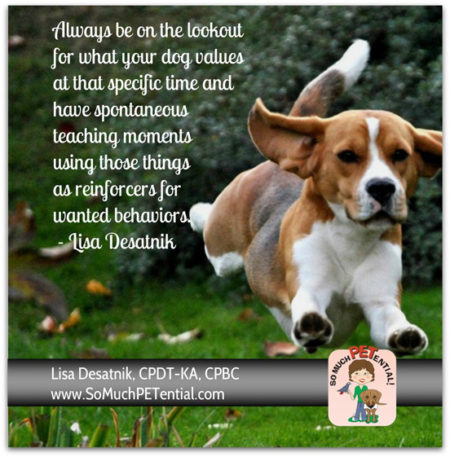Are you among the many dog owners who have a pet those goes into ‘Show me the money’ mode before deciding whether to do anything you ask? It is such a common problem.
Why does it happen? Well, for one, humans are pretty good at holding food in their hand held in plain view when teaching their dog behaviors (so the student is being lured); and humans are also pretty good at responding to attention seeking behaviors by doing something deemed valuable by a smart dog – such as giving attention, a piece of food, or beginning a game of fetch.
 Humans are also pretty good at inadvertently teaching different meaning to cues (such as giving a cue for ‘sit’ and when the dog walks away to find an awesome toy, is called back and given a treat upon arrival which is a multiple reinforcer for walking away instead of ‘sitting’ after the cue). In general, humans are pretty good at breaking down cues by using them at times when the chances are low that there will be success (among many other ways). And dogs are pretty good at figuring out that when the clicker comes out or a bag of treats appears, that suddenly the predictability of reinforcement for certain behaviors goes way up. (Please see my post on discriminative stimulus.)
Humans are also pretty good at inadvertently teaching different meaning to cues (such as giving a cue for ‘sit’ and when the dog walks away to find an awesome toy, is called back and given a treat upon arrival which is a multiple reinforcer for walking away instead of ‘sitting’ after the cue). In general, humans are pretty good at breaking down cues by using them at times when the chances are low that there will be success (among many other ways). And dogs are pretty good at figuring out that when the clicker comes out or a bag of treats appears, that suddenly the predictability of reinforcement for certain behaviors goes way up. (Please see my post on discriminative stimulus.)
Ugh, so, how can you break this cycle?
One way is to build ‘training’ into your everyday life. In other words, always be on the lookout for what your dog values at that specific time such as going for a walk, going out the door, playing tug or fetch, or sniffing a fire hydrant; and have spontaneous teaching moments using those things as reinforcers for wanted behaviors.
Note here that those ‘wanted’ behaviors should be taught in advance in a real training session.
Here are some dog training tips:
Make going out the door contingent upon your dog sitting on a mat until released. (Click here to read how to teach this.)
Make a game of tug contingent upon your dog sitting and waiting until you give your dog a cue to grab the toy. Or you can ask your dog to do any number of already learned behaviors prior to a cue for GAME ON.
Call your dog to come from another room with some kind of reinforcer – be unpredictable here. It could be that sometimes coming to you results in a game of chase or fetch. Other times you may run grab a cookie when he gets to you, or attach a leash (if he enjoys walks).
If your dog is behind a gate, you can teach your dog that his remaining seated while you walk up to and over the gate is what gets you to step over and pet him; while his getting up results in you walking away from the gate.
Do you see the pattern?
With all of these scenarios, the common elements are:
Consistency in cues/feedback to your dog
You are taking that dependence on food out of the equation
You are building value for listening to you and for doing behaviors you ask by teaching a positive association between you and positive consequences of behavior
You are decreasing that dependence on ‘Show me the money’
Here is a challenge for you. Can you name four or more things that your dog values? And can you brainstorm for ways in which your dog can use behaviors to GET those things of value?






